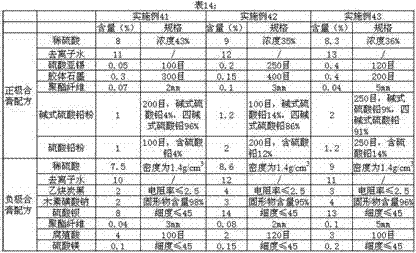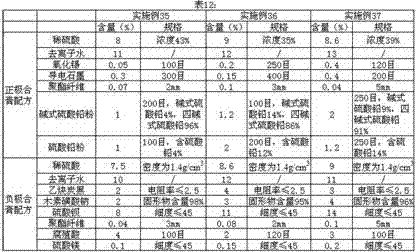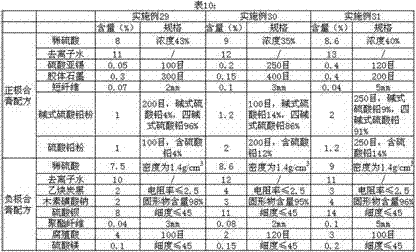Internalization of lead-acid batteries into paste
A lead-acid battery, internalization technology, applied in the direction of battery electrodes, circuits, electrical components, etc., can solve the problems of short battery life, small initial capacity, etc., and achieve the effect of prolonging the life at low temperature and prolonging the discharge time
- Summary
- Abstract
- Description
- Claims
- Application Information
AI Technical Summary
Problems solved by technology
Method used
Image
Examples
Embodiment 1
[0021] A lead-acid storage battery is internally formed into a composite paste. The percentages of each chemical component in the positive electrode composite paste to the mass of the positive electrode composite paste lead powder are: 8%~9% of dilute sulfuric acid with a concentration of 35%~43%, and 11%~ of deionized water. 13%, tin oxide or stannous sulfate 0.05%~0.4%, colloidal graphite or conductive graphite 0.15%~0.4%, short fiber or polyester fiber 0.04%~0.1%, basic lead sulfate powder 1%~2%, sulfuric acid Lead powder 1%~2%; the percentages of the chemical components in the negative electrode paste to the mass of the negative electrode paste lead powder are: 7.5%~9% of dilute sulfuric acid with a concentration of 35%~43%, and 10%~12% of deionized water , acetylene carbon black 2%~4%, sodium lignosulfonate 2%~4%, barium sulfate 8%~14%, short fiber or polyester fiber 0.04%~0.1%, humic acid 2%~4%, Magnesium sulfate 0.1%~0.2%.
[0022] The basic lead sulfate content of the...
PUM
| Property | Measurement | Unit |
|---|---|---|
| electrical resistivity | aaaaa | aaaaa |
Abstract
Description
Claims
Application Information
 Login to View More
Login to View More - R&D
- Intellectual Property
- Life Sciences
- Materials
- Tech Scout
- Unparalleled Data Quality
- Higher Quality Content
- 60% Fewer Hallucinations
Browse by: Latest US Patents, China's latest patents, Technical Efficacy Thesaurus, Application Domain, Technology Topic, Popular Technical Reports.
© 2025 PatSnap. All rights reserved.Legal|Privacy policy|Modern Slavery Act Transparency Statement|Sitemap|About US| Contact US: help@patsnap.com



